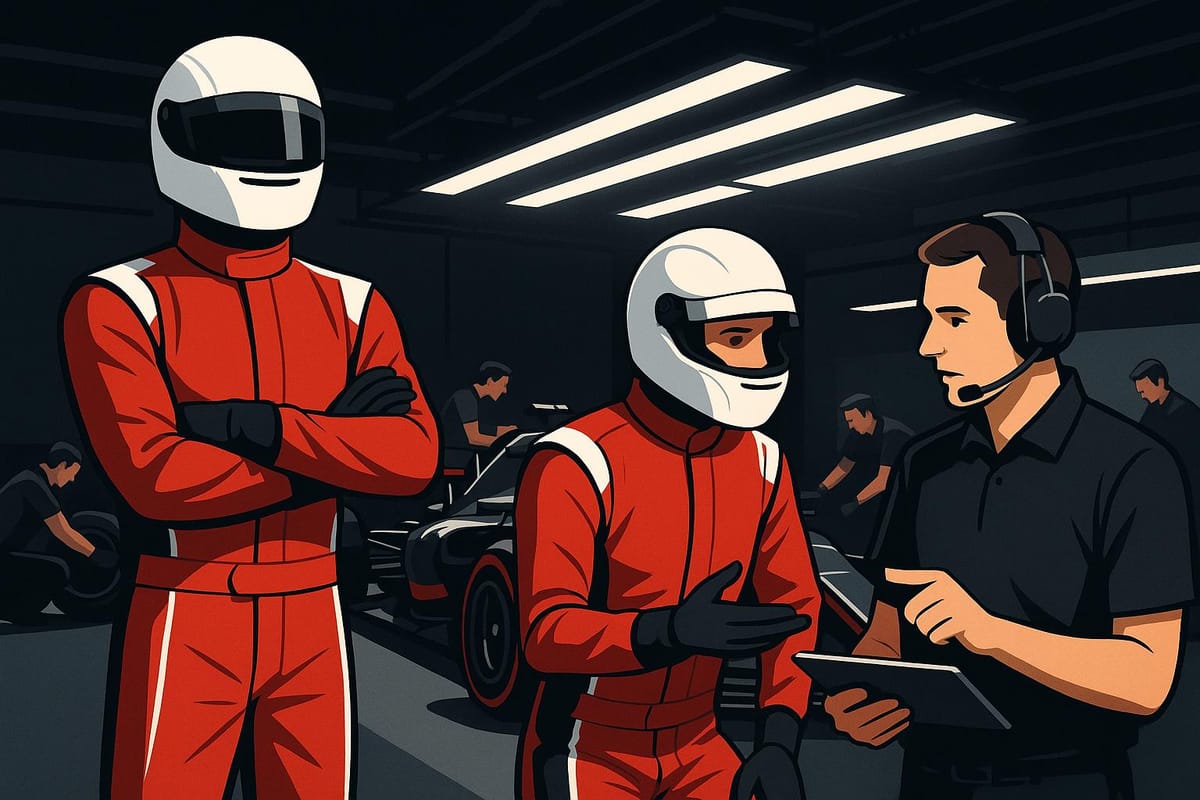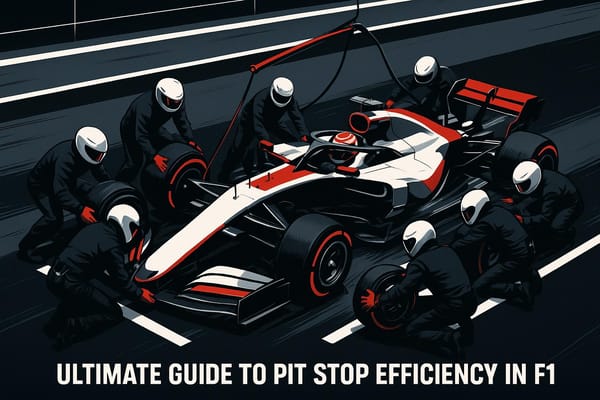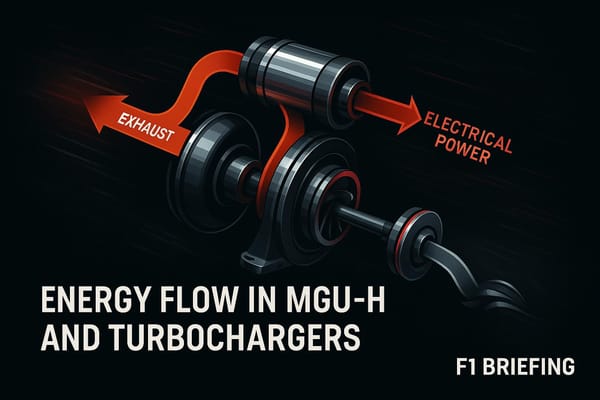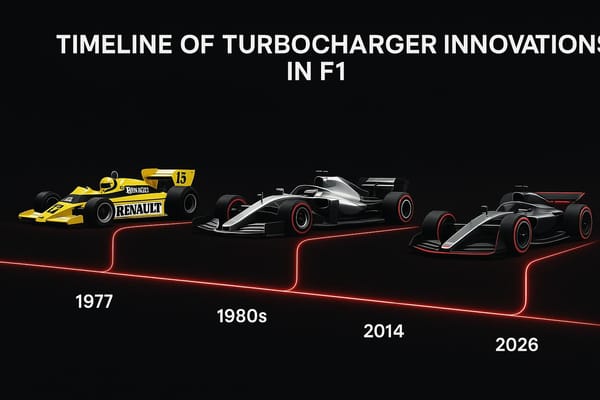How Drivers Shape F1 Team Dynamics
Explore how F1 drivers influence team dynamics, from leadership and morale to collaboration with engineers and decision-making under pressure.

F1 drivers are the backbone of team success. While advanced technology dominates the sport, drivers play a pivotal role in linking engineering, strategy, and on-track performance. Their leadership, communication, and feedback influence everything from car development to team morale. Here’s a quick breakdown of their impact:
- Leadership: Drivers set the tone for their teams, inspire unity, and motivate through both wins and setbacks.
- Feedback: Precise on-track input helps engineers implement up to 1,000 car changes weekly.
- Team Morale: A driver’s attitude and performance directly affect the entire team’s confidence and focus.
- Collaboration: Strong driver-engineer partnerships turn data into performance gains.
In Formula 1, drivers are not just racers - they are leaders who shape the culture, strategy, and success of their teams.
McLaren CEO on why Norris-Piastri Dynamic Is Stronger Than Red Bull’s

Drivers as Leaders: How They Set Team Culture
F1 drivers play a pivotal role in shaping their team's culture and strategy. Their strong performances and precise technical feedback not only drive the team forward but also inspire unity and motivation across the board. In a sport defined by high stakes and precision, drivers are expected to lead not just on race day but throughout the entire season. Their dual role as competitors and strategic leaders profoundly influences the inner workings of their teams.
Leadership Through Performance
Consistent performance is the foundation of a driver's leadership. When drivers deliver results, they earn the respect and trust needed to influence team decisions and foster a positive culture. But leadership through performance isn't just about winning races - it also involves collaborating with engineers to fine-tune the car and push the team forward. Sebastian Vettel, reflecting on his championship-winning years, captured this dynamic perfectly:
"If the boat started shaking, we stayed on course and didn't lose focus. That made the difference".
The physical and mental demands of Formula 1, coupled with split-second decision-making, highlight the resilience required to lead effectively. It’s this combination of skill and composure that sets drivers apart as leaders.
Managing Rivalries Within Teams
Internal rivalries can be a double-edged sword - either fueling performance or fracturing team unity. The partnership between Lewis Hamilton and Nico Rosberg at Mercedes is a prime example. During their time as teammates, Hamilton achieved 32 victories, 55 podium finishes, and two championships, while Rosberg secured 22 victories, 50 podiums, and one championship. Despite intense competition, both drivers maintained a level of professionalism that ultimately strengthened the team.
Modern F1 teams have moved away from strict number one and number two driver roles, opting instead for a more balanced approach. This shift allows both drivers to compete freely while contributing to the team's overall success. When managed effectively, rivalries like Hamilton and Rosberg's can push teams to greater heights, turning competition into a source of strength rather than division.
How Drivers Affect Team Morale
Beyond managing rivalries, drivers have a direct impact on team morale. Their leadership and attitude ripple through the organization, influencing everyone from engineers to mechanics. A positive mindset and constructive communication create a cycle of motivation and improvement, while negativity can quickly erode team spirit. Formula 1 enthusiast Ravi A summed it up well:
"Watching a race car, that you had some part in producing and support passionately, win races (or at least compete for wins) is the biggest thing you need for good moral in a team. A good team, produced good results, which makes it easier for drivers to win. The opposite is equally true. Hence, why a driver, and their attitude and performance, is so important".
Data underscores this connection between morale and performance - 66% of underperforming drivers were replaced, highlighting how critical a driver's contributions are to the team's success. Top drivers understand that leadership is about more than just celebrating victories; it’s about fostering an environment of continuous improvement where every team member feels valued and motivated to innovate. Their ability to lead through both triumph and adversity ensures the team remains focused and driven, no matter the challenges.
Driver-Engineer Collaboration: Working Together for Performance
In Formula 1, the bond between drivers and engineers is at the core of a team’s success. Drivers bring firsthand insights from the track, while engineers translate that feedback into technical adjustments using advanced data analysis. This constant exchange of information can determine victory or defeat in a sport where even a thousandth of a second matters.
Modern F1 teams rely on this partnership to push their cars to the limit. By combining a driver’s instincts with the precision of engineering, teams can refine critical elements like aerodynamics and tire strategies. This collaboration creates a competitive edge that transcends raw speed, forming a feedback loop that directly influences car performance.
The Feedback Loop: Turning Driver Input Into Technical Changes
An F1 car is essentially a rolling data center, equipped with over 250 sensors tracking everything from tire pressure to engine temperature. During a single race, these sensors generate approximately 3 GB of telemetry data and 4 GB of logging data, adding up to over a terabyte of information across a race weekend. But having mountains of data isn’t enough - it’s the fusion of this technical information with driver input that leads to meaningful advancements.
Stephen Watt, McLaren Racing’s head of electronics, highlights the importance of this data-driven approach:
"The car on the track is only the tip of the iceberg; teams are now heavily data driven. The demand for high-quality data shapes a lot of what we do."
The standard ECU in an F1 car monitors more than 4,000 parameters in real time, offering teams instant insights into performance. For European races, live data is processed within 10 to 15 milliseconds, while in far-off locations like Australia or Japan, this can extend to 300 to 400 milliseconds. This rapid flow of information allows teams to quickly address any performance issues.
For example, if a driver reports instability in high-speed corners or fading brakes late in a stint, engineers can cross-check this feedback with telemetry data to identify the root cause. Adjustments to settings like the differential or brake balance can then be made to resolve the issue.
Race engineers play a pivotal role in blending this data with driver observations. They analyze around 400 GB of race data to develop new parts and refine setups, ensuring that driver feedback directly informs these improvements.
Case Study: Successful Driver-Engineer Partnerships
The 2023 British Grand Prix showcased how effective driver-engineer collaboration can shape race outcomes. During the race, engineers advised Lewis Hamilton to back off slightly to preserve his tires, which were under strain after an intense battle with Lando Norris. This strategic decision allowed Hamilton to maintain tire performance until a safety car provided an opportunity for a full tire change, keeping him competitive.
This example highlights the importance of real-time teamwork. Engineers monitor tire degradation and other factors through telemetry, while drivers provide on-the-ground insights about how the car feels. Together, they adapt strategies on the fly to maximize performance.
Race engineers also maintain close communication with their drivers throughout every session. They provide feedback on car behavior, relay strategy updates, and respond to setup requests. Trust and clear communication are essential, forming the backbone of decision-making during race weekends.
Stephen Watt underscores the critical nature of this collaboration:
"The telemetry link is a critical part of the operation of all Formula 1 teams...teams will almost certainly not run a car on track without the visibility of the car's health that the combination of sensors, ECU, and telemetry link gives and allowing engineers to intervene before a fault damages key components."
This seamless integration of driver feedback and technical monitoring ensures not only peak performance but also the protection of vital components. It’s a partnership that goes beyond speed, encompassing every detail of F1 operations to deliver success on race day.
Communication Styles: How Drivers Affect Decision-Making
In Formula 1, effective communication isn't just a nice-to-have - it's a necessity. When cars are flying around the track at over 200 mph, decisions need to happen in milliseconds. The way drivers communicate with their teams during these high-pressure moments can make or break a race. Modern F1 teams analyze over 1,000 data points every second, running more than 2 million simulations to refine strategies. They've managed to cut response times from nine seconds to under five. But all that data is useless without flawless communication between drivers and their teams.
Radio Communication Under Pressure
Drivers play a critical role in how quickly teams can react during a race. The best teams rely on short, clear radio messages, especially when the stakes are high.
Chris Cronin, Race Engineer at Aston Martin F1 Team, explains how crucial it is to strike the right balance:
"A large part of our job is to be the link between the data fed to us from the team at the AMR Technology Campus to the driver – deciding what information we pass onto the drivers, as well as when and how to communicate it."
It's not just about sending information; it's about knowing what not to say. Race engineers constantly sift through thousands of data points to determine what’s actually useful for the driver. During critical moments - like when tires are wearing down or weather conditions shift - drivers rely on real-time updates about the track, weather, and competitors.
A great example of this was during the 2019 British Grand Prix, where precise, clear instructions helped shape an effective race strategy. Interestingly, even informal language, like swearing, can sometimes grab a driver’s attention in the heat of the moment. Another standout moment came during the 2019 Brazilian Grand Prix, when Red Bull Racing pulled off a record-breaking 1.82-second pit stop. This incredible feat was the result of sharp data analysis paired with crystal-clear communication.
This kind of streamlined communication doesn't just improve performance - it builds trust, the cornerstone of any successful driver-team relationship.
Building Trust Between Drivers and Teams
Clear communication is vital, but trust is what allows drivers to fully commit to their team’s strategies. In Formula 1, trust is the glue that holds everything together. When drivers have complete faith in their teams, they're more likely to follow plans, even if those plans go against their gut instincts. And in a sport where split-second decisions can decide a race, that trust can be the difference between winning and losing.
Christian Horner, Team Principal of Red Bull Racing, highlights the importance of this dynamic:
"Formula 1 attracts egos. But, there is no 'I' in 'team'. If you have a talented individual that isn't working in a team environment, they quickly become isolated. F1 is too big of a sport to be an individualist in it. You need to rely on trust in the other people around you, in the other departments around you to be able to fulfill your part."
Building this trust isn’t easy. It requires open, honest communication and a system that minimizes errors during high-stakes moments. Successful teams stick to consistent communication patterns and limit the number of voices involved during critical times, ensuring that messages are clear and decisions are executed smoothly.
David Richards, former Team Principal of BAR, sums it up perfectly:
"At the end of the day it comes to trust. Building a relationship. These people know what they are supposed to do, we have empowered them to do it and let them get on with it."
When drivers know their teams will deliver accurate and timely information, they can focus entirely on their driving. That confidence allows them to push the limits, knowing the guidance they receive is solid. Trust, combined with sharp technical collaboration, forms the backbone of a driver’s leadership role within the team.
Conclusion: Drivers as the Foundation of Team Dynamics
In Formula 1, one thing has always been clear: drivers are the backbone of team dynamics. Whether it's Verstappen shaping Red Bull's car development or Hamilton's championship-winning collaboration with Bonnington, drivers play a pivotal role in steering their teams toward success. Their leadership and technical input influence everything from race-day strategies to long-term performance.
Consider this: F1 teams make roughly 1,000 changes each week to enhance performance, and a two-car team processes an astounding 11.8 billion data points over a season. Yet, all that cutting-edge technology and data would be meaningless without drivers who can interpret what happens on the track and provide actionable feedback. Their ability to build trust and make split-second decisions underscores their importance in the sport’s history.
Key Takeaways for F1 Fans
Drivers reveal the key ingredients for success: leadership, communication, and trust. Some drivers inspire their teams by building strong personal connections, while others rely on sheer performance and technical expertise. Take Fernando Alonso, for example. His adaptability is legendary. Alan Permane, Renault's Sporting Director, once said of Alonso:
"Fernando just overnight changed his driving style completely".
Communication is critical in Formula 1. The high-speed nature of the sport leaves no room for misunderstandings. Missteps can be costly, as seen when Nicolas Latifi received a 30-second penalty during the Azerbaijan Grand Prix due to a pit lane miscommunication. To avoid such errors, teams develop clear codes and shared languages to ensure seamless exchanges during high-pressure moments.
Trust is the glue that holds driver-team relationships together. It fosters a no-blame culture, encouraging experimentation and constant improvement - essential for a sport that thrives on pushing limits.
Looking Ahead: The Changing Role of Drivers in F1
While drivers are central to today’s F1, their role is evolving with the rise of advanced technologies. However, this doesn’t mean their importance will fade. Instead, drivers will need to sharpen their ability to communicate precise feedback and adapt to ever-changing conditions. The skill of translating what they feel on the track into technical insights will become even more valuable as data becomes more complex.
Adaptability will remain a key trait. Future regulations and innovations will demand drivers who can adjust their styles on the fly while working seamlessly within shifting team dynamics. Those who balance instinct with data-driven approaches will stand out.
At its core, Formula 1 is still about the human element. While technology can process 1.5 terabytes of data during a race weekend, it cannot replicate the intuition, leadership, or split-second decision-making that drivers bring to the table. As the sport evolves, the drivers who embrace technology while maintaining strong team bonds will lead the way.
In the future, successful teams will see drivers not just as skilled racers but as strategic leaders - thinkers, communicators, and team builders who influence every aspect of their organization’s quest for victory.
FAQs
How do F1 drivers' leadership skills impact team performance and morale?
F1 drivers' leadership abilities are a big factor in influencing their team's performance and overall morale. When a driver communicates clearly and builds trust, it sets the stage for a collaborative atmosphere. This kind of environment helps engineers, mechanics, and strategists stay motivated and perform at their peak - something that's absolutely crucial in a sport where races are decided in fractions of a second.
Drivers who step up as leaders often make a big difference in race-day decision-making. Their ability to keep things running smoothly ensures strategies are carried out without a hitch. On top of that, when teammates support each other or make sacrifices for the benefit of the team, it strengthens their bond and keeps everyone focused on the goal. In the fast-paced, ultra-competitive world of Formula 1, a driver's leadership can be the glue that holds a team together and drives them toward lasting success.
How do drivers and engineers work together to improve a Formula 1 team's performance?
The relationship between drivers and engineers plays a key role in the success of a Formula 1 team. Drivers offer precise feedback on how the car handles, its performance, and any problems they encounter on the track. Engineers depend on this information to adjust the car's setup, make technical tweaks, and craft strategies aimed at getting the best possible performance.
This teamwork is even more crucial during races, where quick decisions - like when to pit or how to adapt to changing conditions - can make or break the result. Clear communication and mutual trust between drivers and engineers ensure the team can react swiftly, fine-tuning both the car and the strategy to fit every scenario. In the fiercely competitive world of Formula 1, this partnership often separates the winners from those left chasing.
How do F1 drivers handle rivalries with teammates to maintain strong team dynamics?
F1 drivers handle rivalries with their teammates by prioritizing teamwork and clear communication. By openly sharing data and insights, both drivers can push their performance boundaries while ensuring the team as a whole remains competitive. This transparency helps reduce potential conflicts and encourages a constructive competitive environment.
Additionally, top drivers often step into leadership roles within their teams. They lead by example, offering guidance and support during tough moments. Striking the right balance between competition and collaboration is crucial - it keeps team morale high and ensures that rivalries don’t negatively impact overall performance.




